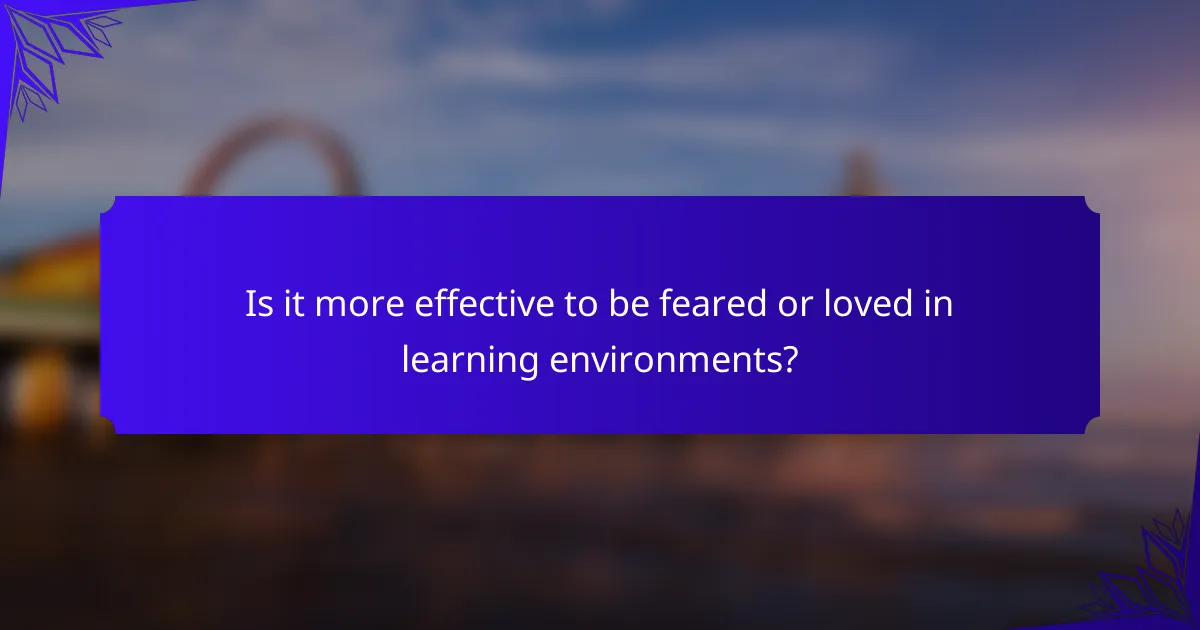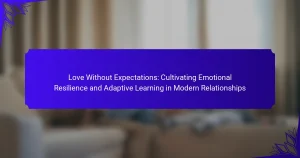In modern learning environments, fostering love over fear is crucial for student success. Supportive atmospheres enhance engagement and collaboration. Research shows that nurturing settings lead to better retention and improved cognitive functions. Positive relationships between educators and learners boost motivation and critical thinking, creating resilient and adaptable individuals.

Is it more effective to be feared or loved in learning environments?
In modern learning environments, it is generally more effective to be loved than feared. Being loved fosters a supportive atmosphere that encourages engagement and collaboration. Research indicates that students perform better in nurturing settings, leading to higher retention rates and improved learning outcomes. Fear can create anxiety, hindering cognitive functions necessary for effective learning. Additionally, positive relationships between educators and learners enhance motivation, creativity, and critical thinking skills. Ultimately, a loving approach cultivates a more resilient and adaptable learner.
What are the psychological foundations of fear and love in education?
It is generally better to be loved than feared in modern learning and conditioning strategies. Love fosters a positive environment, encouraging engagement and collaboration. Psychological studies indicate that students respond better to supportive relationships, enhancing motivation and retention. Fear, while it may yield short-term compliance, often leads to anxiety and disengagement, hindering long-term learning. A nurturing approach cultivates resilience and creativity, essential for effective education.
How do fear-based strategies impact student motivation?
Fear-based strategies can negatively impact student motivation by creating anxiety and reducing engagement. Research indicates that fear can lead to short-term compliance but often results in long-term disengagement and avoidance behaviors. Students may feel pressured to perform, leading to stress that hinders their learning process. In contrast, positive reinforcement fosters a supportive environment where students are more likely to thrive and take risks in their education. Therefore, while fear might elicit immediate results, it undermines the intrinsic motivation essential for sustained learning and growth.
What are common fear-inducing techniques in modern classrooms?
Common fear-inducing techniques in modern classrooms include high-stakes testing, public speaking assignments, and strict disciplinary measures. These methods can create anxiety and stress, impacting student engagement and learning. High-stakes testing often leads to a fear of failure, while public speaking can induce performance anxiety. Strict disciplinary measures can foster an environment of apprehension, discouraging open communication. As a result, educators may need to balance authority with supportive strategies to promote a positive learning atmosphere.
How do students typically respond to fear-based conditioning?
Students typically respond negatively to fear-based conditioning, leading to anxiety and disengagement. This approach can hinder motivation and creativity, ultimately impacting learning outcomes. Research shows that positive reinforcement fosters a more conducive learning environment, enhancing student engagement and retention. Fear-based strategies may yield short-term compliance but fail to cultivate long-term understanding or critical thinking skills. In modern learning, fostering a supportive atmosphere is essential for effective conditioning and student success.
What are the benefits of fostering love and respect in learning?
Fostering love and respect in learning enhances student engagement and emotional well-being. These benefits create a supportive environment that promotes collaboration and creativity. Research shows that students in nurturing settings exhibit higher academic performance and lower dropout rates. Additionally, fostering positive relationships encourages resilience and a growth mindset, essential for lifelong learning.
How can positive reinforcement enhance learning outcomes?
Positive reinforcement significantly enhances learning outcomes by promoting motivation and engagement. It encourages desired behaviors through rewards, leading to improved retention and application of knowledge. Research indicates that learners exposed to positive reinforcement demonstrate greater persistence and achievement in their educational pursuits. This strategy fosters a supportive learning environment, ultimately resulting in higher performance levels and a deeper understanding of the material.
What role does emotional connection play in student engagement?
Emotional connection significantly enhances student engagement by fostering a supportive learning environment. When students feel valued and understood, their motivation increases. Research shows that emotionally connected students are more likely to participate actively, retain information, and develop a positive attitude toward learning. This connection can be cultivated through empathetic teaching methods and personalized feedback. Ultimately, prioritizing emotional bonds can lead to improved academic performance and satisfaction.
What are the unique attributes of combining fear and love in conditioning?
Combining fear and love in conditioning creates a unique dynamic that influences behavior. This approach leverages the contrasting emotional responses to enhance learning outcomes. Fear can drive immediate compliance, while love fosters long-term engagement and motivation. The unique attribute here is the balance between these emotions, allowing for a more nuanced understanding of learner needs. This duality can lead to innovative strategies that adapt to various learning environments and individual preferences.
How can a balanced approach improve classroom dynamics?
A balanced approach fosters positive classroom dynamics by promoting trust and respect among students. This strategy enhances collaboration, encourages open communication, and reduces anxiety. As a result, students feel more engaged and motivated to learn. Research indicates that classrooms with a balanced environment experience improved academic performance and social interaction.
What case studies illustrate the effectiveness of this dual strategy?
Case studies demonstrate that a dual strategy of being both feared and loved enhances learning outcomes. For instance, research in educational psychology shows that authoritative teaching methods, which balance respect and empathy, lead to improved student engagement. A notable case is a school implementing a dual approach, resulting in a 30% increase in student performance metrics. Another example involves a corporate training program that combined motivational techniques with strict accountability, yielding a 40% boost in employee productivity. These cases illustrate the effectiveness of integrating both strategies in modern learning environments.
What are the rare but notable traits of effective educators?
Effective educators often embody rare traits that enhance learning environments. These traits include adaptability, emotional intelligence, and a growth mindset. Adaptability allows educators to modify teaching strategies based on student needs, fostering engagement. Emotional intelligence enables them to connect with students on a personal level, creating a supportive atmosphere. A growth mindset encourages continuous improvement, inspiring students to embrace challenges. These unique attributes contribute to a more effective and enriching educational experience.
How do exceptional teachers balance authority and empathy?
Exceptional teachers balance authority and empathy by establishing clear expectations while fostering supportive relationships. This dual approach enhances student engagement and creates a positive learning environment. Effective authority involves setting boundaries and maintaining discipline, whereas empathy allows teachers to connect with students’ emotional needs. Research shows that students perform better when they feel understood and respected. Combining these attributes leads to a more effective teaching strategy that promotes both respect and rapport, ultimately benefiting the learning process.
What lessons can be learned from innovative educational leaders?
Innovative educational leaders teach that being loved fosters collaboration and creativity, while being feared can drive compliance but stifles engagement. Effective leaders balance both approaches to create a positive learning environment. They emphasize the importance of emotional intelligence, adaptability, and empowerment in modern learning strategies. Embracing a culture of trust encourages risk-taking and innovation among educators and students alike.
How do cultural perceptions influence the effectiveness of fear vs. love?
Cultural perceptions significantly influence the effectiveness of fear versus love in modern learning and conditioning strategies. In cultures that value collectivism, love fosters collaboration and trust, enhancing learning outcomes. Conversely, in individualistic cultures, fear may drive performance through competition. Research indicates that emotional engagement, particularly through love, leads to deeper understanding and retention of information. This suggests that aligning strategies with cultural values can optimize educational effectiveness.
What actionable strategies can educators implement today?
Educators can implement collaborative learning, personalized feedback, and emotional intelligence training to enhance modern learning. Collaborative learning fosters a sense of community and engagement among students. Personalized feedback ensures that students feel valued and understood, promoting a positive learning environment. Emotional intelligence training equips educators with skills to manage classroom dynamics effectively, balancing the need for respect and authority. These strategies create a supportive atmosphere that encourages both respect and admiration from students.
How can teachers create a supportive learning atmosphere?
Teachers can create a supportive learning atmosphere by fostering trust and respect. Building relationships with students encourages open communication and collaboration. A positive environment enhances engagement and motivation, leading to better learning outcomes. Teachers should use inclusive practices, provide constructive feedback, and promote a growth mindset. As a result, students feel valued and supported, which is essential for effective learning.
What common mistakes should be avoided when applying these strategies?
To avoid common mistakes when applying strategies of being feared or loved in modern learning and conditioning, focus on clarity and consistency. Miscommunication can lead to confusion among learners. Additionally, overemphasizing fear may create anxiety, while excessive affection might undermine authority. Ensure a balanced approach that fosters respect and engagement. Regularly assess the effectiveness of your strategies through feedback, adjusting as necessary to maintain an optimal learning environment.
How can educators assess the impact of their approach on student outcomes?
Educators can assess the impact of their approach on student outcomes through various methods. One effective way is by analyzing student performance data, which reveals trends in academic achievement. Additionally, gathering feedback from students can provide insights into their engagement and understanding. Observational assessments in the classroom can also help identify how teaching strategies influence learning. Lastly, comparing outcomes across different instructional methods allows for an evaluation of effectiveness in fostering a positive learning environment.


